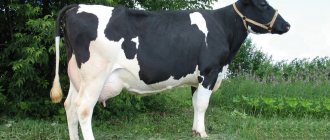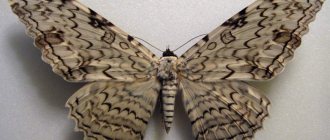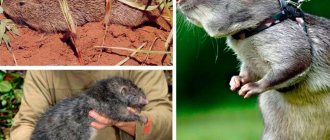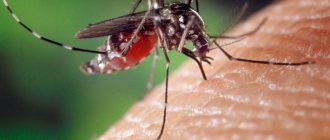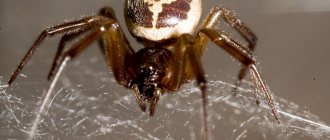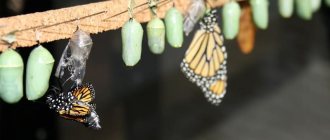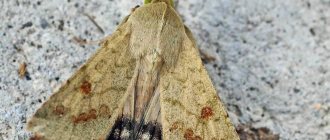A moth is an insect belonging to a species characterized by a wealth of species diversity. They are distinguished by the fact that they lead an active life mainly at night or at dusk. These insects differ from daytime insects in structure, having a longer body, and coloring - which is not as bright and colorful as those of sunlight lovers.
Appearance and structure of butterflies
Moths are called moths with different antennae, which is associated with the anatomical structure of the antennae, which look like feathers or threads.
What does a moth look like? Its body, like that of other species of this order of insects, has three sections, abdomen, sternum and head . The latter of butterflies does not differ in size; it is decorated with eyes and large antennae. There are 2 pairs of wings on the insect's chest, and its body is covered with tiny scales and hairs.
The oral apparatus has some features:
- the proboscis, with the help of which the insect takes food, is presented in the form of a flat spiral that folds and unfolds and opens directly into the larynx;
- when the proboscis is not required, it is twisted and hidden under the scales covering the butterfly's head;
- when expanded, the proboscis is ideally suited for absorbing liquids;
- adult individuals have jaws (similar ones can be seen in caterpillars and other types of insects), allowing them to chew through the necessary objects.
As for the wings, they practically do not differ from those found on daytime individuals. Night beauties have 2 pairs of wings, which are quite densely dotted with tiny hairs, as well as scales that form clusters of hairs.
The structure of the wings may differ among different subspecies:
- a butterfly may not have wings at all (this structure is passed on by insects from generation to generation and is an evolutionary manifestation);
- have a wide wing surface;
- have very narrow wings, almost linear.
The flight that a butterfly can demonstrate depends on the structure of its wings. For example, male mothfish are excellent flyers who dive superbly in the night sky. And their females can be either with or without wings.
On the other hand, there are known species of moths that have wings of a standard size and shape that do not allow the insect to fly (for example, the silkworm). The best developed flying apparatus is in the nocturnal moth - the hawkmoth subspecies, whose narrow wings have a high flapping frequency, allowing them to fly quickly and hover in the air for a while, as hummingbirds do.
Some subspecies of moths (the same hawk moth, glass moth) have no scales or hairs at all on the surface of their wings. However, this fact does not in any way affect their ability to fly; the narrowness of the wings allows them to stay stably in the air.
Small individuals have rather narrow wings, which keep them in the air only due to the thick scales located on the sides.
The main difference between diurnal and nocturnal butterfly species is the mechanism for attaching the rear and front pairs of wings:
- Bridle : in this case, a small process extends from the hind wings, which is inserted into a segment of the front wing. In males it is located on the lower part of the forewing, in females it is at the base of the medial vein; it is a cluster of villi.
- Jugum : on the forewing there is a small blade, which is fixed at its base. It is she who fastens both wings to each other.
The hawk moth is also active at night
Description of the appearance of meadow moths
Meadow moth (Loxostege sticticalis).
The color of the front wings of the meadow moth is gray-brown, brown spots are scattered over the entire surface of the wings, and a yellowish stripe borders the outer edge. The hind wings are gray.
Females are larger than males - the wingspan of females reaches 26 millimeters, and that of males is approximately 20 millimeters. The antennae of males are serrated, while those of females are thread-like.
The caterpillar's body length reaches 35 millimeters. The body color is greenish, and a characteristic feature is a languid stripe running along the back.
The sense organs of butterflies are presented as follows:
- Olfactory organs : in a moth they are outgrowths shaped like a cone or a wedge. Around them there are a number of sensory cells that lie in the deep layers of the skin and connect to the nerves responsible for sensory functions. Butterflies' sense of smell is quite acute, and it is thanks to it that they find males, females or food.
- Hearing organs : some individuals are distinguished by the presence of tympanic organs, which are absent in diurnal moths. Receptors of this type are located on the abdomen or back of the sternum, in special lateral recesses, which are covered with a cuticular membrane (underneath there is a trachea). Sound waves that travel through the air cause the membrane to vibrate, causing cells to be excited and information to be transmitted through sensors.
- Organs of vision : moths have two faceted eyes that occupy the main surface of the head. These organs of vision have the same structure as those of other insects: they consist of many small elements, including the lens, retina and innervation. As a rule, moths see much better up close than at a distance. The organs of vision of moths are designed, first of all, to detect oncoming movement and move in space themselves.
The eyes of butterflies are designed in such a way that they perceive all information separately. Therefore, the insect receives a mosaic image as output, which enlarges the real image of the object several times.
Eye structure
Hawkmoths in the wild
Beautiful and unusual hawk moths often become food for many other animals. They attract:
- birds;
- spiders;
- lizards;
- turtles;
- frogs;
- praying mantis;
- ants;
- Zhukov;
- mice.
Most often, pupae and eggs suffer only because they are immobile.
But caterpillars can suffer from:
- parasitic fungi;
- viruses;
- bacteria;
- parasites.
Features of color
Having seen the flourishing of these insects, many wonder whether moths are dangerous. In fact, they are no more dangerous than the daytime varieties, but the pigmentation of the moths deserves attention.
The color of butterfly wings has a dual nature: structural and pigment . This means that the scales that are located on the surface of the insects’ body contain pigment. It is this substance that absorbs the sun's rays or simply daylight and reflects them, due to which the solar spectrum of shades visible to the human eye appears. As for the structural part of the color, it appears as a result of the refraction of the sun's rays, which does not require the presence of pigment.
Important! Moths have predominantly pigmented coloration.
Features of the lifestyle of meadow moths
Meadow moths are common insects.
Meadow moths are crepuscular butterflies and are active after sunset. Adults feed on plant nectar. And their lifespan is only 4-20 days.
The habitat of meadow moths is very wide, covering vast areas of North America, Europe and Asia. The largest colonies of these butterflies are found in forest-steppe and steppe areas.
A winged individual of the meadow moth.
As noted, these butterflies are highly fertile - they can reproduce in huge numbers, causing damage to farmland. Small meadow moths are able to move considerable distances using air currents. When a large number of meadow moths fly, it seems as if snow is falling, which is why the butterflies began to be called “blizzards”, in addition they are called motilits and bloodworms.
The diet of caterpillars consists of any terrestrial parts of plants on which they settle. When the caterpillars completely destroy one plant, they crawl to a new one. Caterpillars of meadow moths are highly mobile; they are able to cover about 60 meters in just an hour.
Ways to protect yourself from enemies
The moths of Russia, and all others, are created by nature in such a way as to have protection from ill-wishers.
A list of defense mechanisms of moths is presented below.
Construction of shelters : different subspecies of moths organize similar protective structures for themselves. For example, caseworms and bagworms. The caterpillars of these moths, some time after hatching, build houses around which they attach pieces of foliage and various debris.
These shelters are designed in a special way so that the larva protrudes from them just enough so that in case of danger it can quickly hide inside . The house grows with its owner, at least until she grows up and becomes a pupa (this size is approximately 4-5 cm). After the allotted time, the butterflies come out, but only if we are talking about males. The females stay in these houses longer, until they are fertilized by the male and lay eggs.
Defensive body structures , including hairs and glands, are also defense mechanisms for moths. Do moths bite, having such a formidable weapon? The answer is obvious: only if necessary.
Many caterpillars have a series of bristles or hairs that can burn with poison hidden in the skin glands. During an attack, a dangerous mixture is sprayed from the tip of the bristles, which irritates the skin of the enemy.
In addition, insects use the following means of protection:
- glands in the larvae, with the help of which they cover their own bodies with a liquid that repels approaching predators;
- individual individuals begin to actively move when the enemy approaches, or pretend to be dead, or curl up into a tight ball;
- the larvae, at the moment of approaching danger, can fall from the branches on which they live, hanging on thin silk threads (the individual returns back along the same thread, slowly moving along it with its legs located on the chest and oral appendages);
- hawk moths have dorsal growths that look like horns, which they point towards approaching danger;
- insects can defend themselves with the help of long, prickly hairs covering their body.
The pupae of moths, so helpless in appearance, also have mechanisms to protect themselves from a sudden enemy attack:
- pupae living in the soil are colored in colors that make them invisible;
- moths weave silk cocoons (in the silkworm, such shelters can have up to three layers - loose, dense and filmy), in which they hide from attacks by predators.
Coloring to protect against predators
The protective pigmentation of moths has two types of colors:
- Patronizing (cryptic) - helps butterflies to merge with the surrounding space. For example, a moth can completely blend in with the needles on a spruce tree or the leaves on a tree. Other subspecies may have the appearance of tree knots, freezing on a branch at the moment of danger, pretending to be the smallest branches (this is what moths and ribbon moths do).
- Warning (repellent) - in itself attracts the attention of predators, but draws their attention to the fact that the individual has protective means in its arsenal (unpleasant taste, caustic secretion of the glands, the presence of burning hairs on the surface).
The ability of moths to camouflage themselves when danger approaches is admirable. Some blend in with granite rocks, others take on the appearance of bird droppings, and others take on the appearance of bark, flowers or foliage.
Ribbon flies are distinguished by their color, which is visible during flight on their outstretched hind wings. However, this species is completely invisible at rest, if the butterfly folds its wings, the pattern on its back resembles foliage or tree bark.
The wings of night beauties are often decorated with a pattern in the form of wide open eyes. This helps keep predators at a distance.
Eye pattern on wings
The most beautiful moths
In our latitudes, moths are inconspicuous; they do not have an attractive color, but rather a protective one. A small black moth will not attract attention, but there are other species.
- Venezuelan Poodle. It was first described quite recently, in 2009, but it has not yet been possible to classify it. A distinctive feature is the hairiness of the butterfly; its hairs are longer and thicker than those of other representatives of Lepidoptera.
- Saturnian moon. This species is considered one of the largest moths, the wingspan of an adult is up to 12 cm. It lives in the forests of North America, preferring the east coast of the mainland.
- Peacock eyes. This species is recognized as one of the most beautiful and largest; the wingspan of the butterfly can reach 25 cm. The colors are variegated.
- Saturnia cecropia. The caterpillars feed exclusively on maple leaves, and the insect itself is nocturnal. It differs from all others in its large size; its wingspan opens to 12 cm.
- Fingerwing. The strange shape of the body allowed this moth to get into the rating. The body structure resembles the letter T, the wings are thin, and the butterfly itself looks fragile. The caterpillar of this species eats carnivorous sundews.
- Royal walnut moth. Its homeland is the south of North America, the wingspan is not very large, only 10 cm, but the fatness of the insect allows it to be considered one of the largest in the world. It is also called the red moth because of the specific color of its wings.
There are many moths on the globe, most of them are nocturnal. They do no harm, but their caterpillars can cause a lot of trouble.
Industrial melanism
Industrial melanism is the presence in the body of moths of a pigment that makes them darker than other individuals. This ability is inherited.
Currently, there is a tendency towards an increase in individuals of the melanized species, especially for populations living in Europe. If previously the light color of the night moth was the species norm, today dark moths are replacing them. Despite the fact that the survival rate in nature is higher in light-colored moths, dark ones are better adapted to life with nutritional deficiencies. However, constant clashes with predators leave melanists in the minority.
In areas with industrial production, where many objects of the plant world are covered with soot, melanistic butterflies survive better than their white counterparts, because their camouflage abilities are higher . In addition, they feed on food that is contaminated with industrial waste and this does not in any way affect their life activity, unlike light-colored moths.
Life cycle
How long do moths live? The life cycle of these insects deserves close study; it can be divided into several successive stages:
- Eggs are laid by these moths either in the form of heaps or individual specimens. Moreover, females are able to lay them directly during flight, place them on objects or in vegetation tissues.
- After the allotted time, caterpillars emerge from the eggs, having a head, three pairs of legs with marigolds on the chest, and five pairs of legs on the body. After surviving periods of molting, the caterpillars are enclosed in a cocoon called a pupa. In it, the individual cannot move; the paws are tightly pressed to the body.
- After a while, an adult moth emerges from the pupa.
Reproduction
Moths are insects with a full cycle of transformation. Mating occurs at the end of spring. Fertilized females lay up to 200 large, pale green eggs on the leaves of host plants. After 7-10 days, caterpillars appear. With age, their color changes slightly.
At the end of June, the caterpillars descend from the trees to pupate in the soil at a depth of 2-3 cm. The pupa is black. In warm climates, a young butterfly emerges from it by July. She needs to crawl to a higher place to spread her wings. Holding onto a branch with its feet, the moth hangs down, hemolymph flows through the veins of the wings and gives them the desired shape. Autumn pupae remain overwinter; adults are born the following spring.
Information. Some of the pupae are eaten by natural enemies - moles and shrews.
What do butterflies eat?
Some time after the transformation from a pupa to a butterfly, it destroys all the protein in its reserves and goes in search of food.
All butterflies have a proboscis - long and mobile, which is formed from elongated and modified jaws; it is this that allows them to suck nectar from flowers or juice from crevices in trees and fruits. If the butterfly is ready to eat, its proboscis, which is always curled, unfolds, allowing it to feast on something or drink water.
As a rule, the proboscis of moths differ in their length . The latter depends on the depth of the flowers on which one or another individual usually feeds. For example, in tropical hawkmoths, the size of the proboscis can reach a quarter of a meter.
A butterfly that flies from flower to flower in search of food also pollinates plants. This occurs by transferring pollen on stalks from one specimen to another.
What do moths eat:
- fruit juice;
- juices of various plants;
- rotting fruits and vegetables;
- sweet substance secreted by aphids;
- bird excrement;
- flower nectar.
Methods of food absorption may vary among different subspecies of night beauties.
- Large swallowtails flutter their wings while drinking, hovering over the plant, and only slightly touch the petals with their limbs. Therefore, space is important for them, so that nothing interferes with the unfolded wings in movement.
- Hawkmoths also hover in space, like hummingbirds; they never land on a flower or touch the corolla.
- Other species traditionally sit on the flower and leisurely enjoy the sweet nectar. At the same time, their luxurious wings are folded.
They feed mainly on nectar from flowers
Hawkmoth hovers over a flower while eating
Trogonoptera trojan
Trogonoptera trojana, male
Another beauty, occupying 8th place in our list of giants, is Trogonoptera trojana (lat. Trogonoptera trojana). A very rare butterfly that lives only on the island of Palawan (Philippines). The wingspan of this species reaches 17-19 centimeters. Males are smaller in size, but their color is brighter.
Habitat
Moths are distributed almost everywhere; they cannot be found only in Antarctica. The ability of moths to fly is very developed, so they can be found both on the continent and on islands in the ocean.
Moths in central Russia are a fairly common phenomenon. They can be found even in the most abandoned places, traveling through the air on silk threads to which they are attached. In addition to this method of movement, caterpillars can move by attaching to broken branches of trees or whole logs that were moved from place to place after heavy rains or the flow of a river.
Some nocturnal moths live only in the habitats where they first appeared. For example, the yucca moth starts and lives only in yucca thickets.
The following moths are known in the Moscow region:
- fine strands;
- bagworms;
- wood borers;
- cocoon worms;
- birch silkworms;
- slugs;
- peacock eyes;
- corydalis;
- moths;
- nolides.
Ornithoptera goliath
Ornithoptera goliath: male above, female below
Ornithoptera goliath, or birdwing goliath (lat. Ornithoptera goliath), measures up to 20-22 centimeters and lives on the islands of Southeast Asia. Due to their island distribution, several subspecies are distinguished among them, which differ in nuances of color.
Benefits and harms
One interesting sign is associated with moths: if a representative of this type of insect flies into a house, this promises its owners a lot of pleasant things, in the form of good luck and prosperity.
Moths, which have a mouthpart with a soft proboscis that cannot pierce tissues of plant and animal origin, do not cause any harm to humans. In addition, they bring a lot of benefits. They pollinate a variety of plant crops by feeding on pollen . For example, yucca can only be pollinated by yucca butterflies, whose ovules cannot be fertilized without an external pollinator. These butterflies fashion a ball of pollen, which is placed on the pistil of a plant.
The behavior of moths is quite complex, but it is precisely this that ensures the reproduction of certain types of crops.
However, these beautiful moths can not only bring benefits, but also some harm. The caterpillars of these individuals are quite voracious, due to which the following damage is caused:
- damage to foliage, roots and stems;
- eating food;
- damage to fibers and materials.
The larvae of night moths can greatly harm agriculture. For example, keratophagous moths lay their eggs on the fur and hair of domestic animals. Occasionally they use these raw materials to build their own cocoons.
Known harm is caused by:
- grain moth;
- Indian meal moth;
- barley moth;
- mill fire.
These insects are capable of destroying grain stored in warehouses. These types of butterflies are distributed throughout the world, which forces farmers to constantly use insecticides to protect their farms from extermination.
The caterpillars, a type of leaf miner or miner, feed on plant elements found in the central part of the foliage. In order to get to them, the caterpillars gnaw through long passages and cavities located under the epidermis. Other larvae are capable of making real miniature tunnels inside the root system, branches and trunks of trees. In such a secluded place they live for quite a long time, reliably hidden both from predators who encroach on them and from the person trying to exterminate them.
The most noticeable damage caused by moth caterpillars is the destruction of leaf cover. Hungry larvae sometimes become a real disaster; they are capable of completely denuding fields, removing foliage from plants in vegetable gardens, and even completely changing the appearance of green spaces.
Why do butterflies strive for light?
The question of why moths fly towards the light interests many. Moreover, not only nocturnal varieties of moths, but also daytime ones can fly towards the beckoning rays, often by mistake. Although such a reaction is more often due to the fact that such individuals simply fell asleep near the light source, and when darkness fell and it turned on, they became frightened and rushed to escape.
Artificial light has a huge negative impact on nocturnal insects; this trend is especially pronounced in megacities, where there are a lot of light sources. Every year, carried away by the alluring electricity, millions of moths die.
According to recent studies, moths are increasingly less likely to seek light. This is due to the formation of special behavioral mechanisms in them that help them avoid harmful effects. Researchers used ermine moth caterpillars. These insects were raised until the first molt, half in suburban areas with a minimum of artificial lighting, the other half in areas where street lighting was maximum. As the results of the study showed, those butterflies that emerged from caterpillars that grew in places with bright lighting were 30% less likely to rush into the light than those that grew in areas with a minimum of light.
Blind Hawkmoth
Singing night sweet lover
Many beekeepers call the hawk moth the night singing robber or the thieving wolf. And although he has many such nicknames, they are all fair in their own way. The fact is that the original ability of the death's head hawk moth to make sounds has long been noticed and described.
If you take it in your hand, it not only releases a drop of dark brown liquid, but also begins to distinctly squeak and squeak. He makes similar sounds when trying to get out of the room, hitting the window glass or crawling along it.
However, the tonality and timbre of the hawk moth's sound signals, it turns out, is not limited to just a sharp whistle, otherwise beekeepers would not consider it a night thief. The fact is that at night it easily penetrates through the entrance into the beehives.
The bees, having heard the imitating sounds, strongly reminiscent of the birth of a new queen honey bee, which in such a sound way gives a conditioned signal to the worker bees about her birth, emitted by the hawk moth, temporarily lose activity, freeze and become numb.
The hawkmoth is helped to pass the hive guards by the hard cuticle of the cuticle, which protects it from bee venom, to which it is insensitive.
In addition, the death's head hawk moth uses chemicals inside the hive to mask its smell and calm the furry bees.
Thanks to this, he easily pierces the honeycombs of wild and domestic bees, eating from 5 to 15 grams of nutritious honey at a time.
However, it cannot cause significant harm, since it is single, and therefore cannot destroy the hive.
Sometimes the onomatopoeia and camouflage of the hawkmoth do not work, and then a swarm of bees attacks the night thief, causing them great anxiety, resulting in the instant death of the butterfly.
Of particular interest are the numerous reports from beekeepers that the sounds that the death's head hawk moth makes when it enters the hive no longer resemble sharp creaks and whistles. From time to time, a butterfly feasting on fragrant honey buzzes faintly.
To prevent the hawk moth from causing disturbance to the bees, beekeepers should reduce the height of the entrance to 8 millimeters or cover the entrance with a metal mesh with small cells strictly tailored to the size of the tireless domestic workers - the bees.
In addition to honey, food for this rare butterfly is:
- sweetish juice of fruit trees and nectar of flowers,
- honeydew on plant leaves in the form of a sticky, sweetish liquid of animal origin,
- as well as berries, fruits and slightly damaged fruits.
Species of moths
Moths are traditionally divided into 2 subspecies:
- Palaeolepidoptera are represented by miner caterpillars and small forms.
- Neolepidoptera , this includes most butterflies.
Representatives of these subspecies differ from each other in various characteristics relating to the structure of the larvae, mouthparts, wings and genitals.
Night butterflies include:
- glass bees, slender, similar to bees with the thinnest scaleless wings;
- moths, small individuals with triangular wings, most often pests;
- fingerwings, distinguished by dissected wings with scaly fringe;
- true moths, tiny specimens with scales along the edges of their wings;
- notch-winged moth, which has a bright color and is a dangerous pest;
- hawk moths, a large species of butterfly similar to hummingbirds;
- bagworms, in the form of round dark females and males, devoid of wings;
- peacock eye, which has wide wings with a pattern in the form of eyes and a dense body;
- moths, very slender butterflies whose caterpillars crawl, bending in the form of a loop;
- leaf rollers, whose folded wings are shaped like a bell, and the individuals themselves are pests that eat buds and apples;
- cocoon moths, hairy beauties whose caterpillars cause a lot of damage to foliage;
- she-bears with brightly colored wings;
- scoop, inconspicuous butterflies whose wings are brown and antennae in the form of threads;
- moths, the females of which do not have wings, and the males sport gray wings with antennae.
Queen Alexandra's Birdwing
Queen Alexandra's Birdwing, male
The butterfly called Queen Alexandra's Birdwing, or Queen Alexandra's Ornithoptera (Latin: Ornithoptera alexandrae) is the world's largest diurnal butterfly. These butterflies live only on the island of New Guinea and, unfortunately, are so rare that they are even listed in the International Red Book as an endangered species. The wingspan of this butterfly reaches 27 centimeters, and males and females differ significantly in the color and shape of their wings.
Queen Alexandra's Birdwing: male above, female below
Photos with names
Night peacock eye
Green moth
Peacock eye - large nocturnal peacock eye
